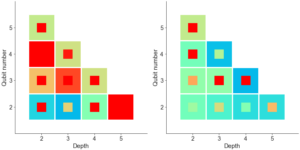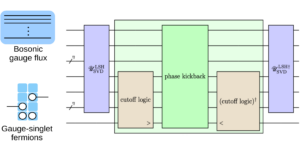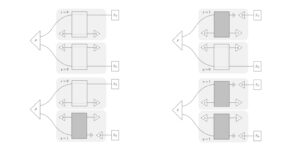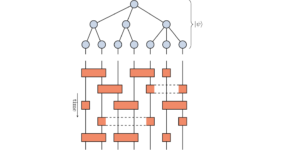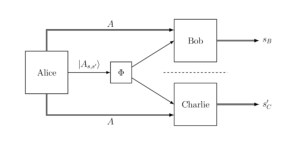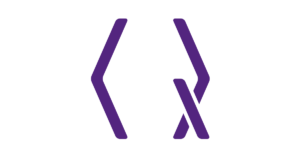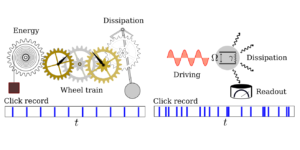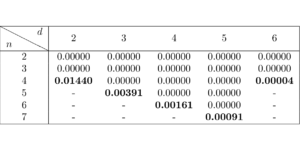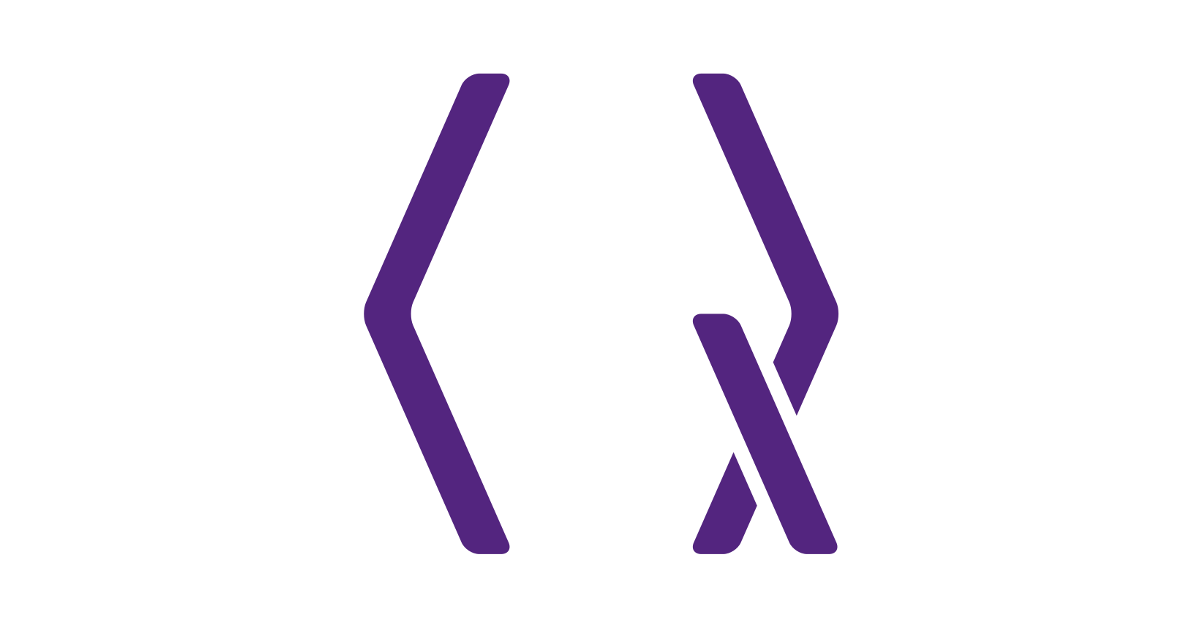
1NEST, Scuola Normale Superiore e Istituto Nanoscienze-CNR, I-56126 Pisa, Italia
2Ingeniería eléctrica e informática, Universidad de Illinois Urbana-Champaign, Urbana, Illinois, 61801, EE. UU.
¿Encuentra este documento interesante o quiere discutirlo? Scite o deje un comentario en SciRate.
Resumen
Introducimos un nuevo conjunto de canales cuánticos: canales resonantes de amortiguación de amplitud multinivel (ReMAD). Entre otros casos, pueden describir los efectos de disipación de energía en sistemas atómicos multinivel inducidos por la interacción con un entorno bosónico de temperatura cero. A diferencia de la clase ya conocida de canales de amortiguación de amplitud multinivel (MAD), esta nueva clase de mapas permite la presencia de un entorno incapaz de discriminar transiciones con espacios de energía idénticos. Después de caracterizar el álgebra de sus reglas de composición, analizando el caso qutrit, mostramos que este nuevo conjunto de canales puede exhibir degradabilidad y antidegradabilidad en vastas regiones del espacio de parámetros permitido. Allí calculamos su capacidad cuántica y su capacidad clásica privada. Mostramos que estas capacidades se pueden calcular exactamente también en regiones del espacio de parámetros donde los canales no son degradables ni antidegradables.
► datos BibTeX
► referencias
[ 1 ] D. Cozzolino, B. Da Lio, D. Bacco y LK Oxenløwe, Advanced Quantum Technologies 2, 1900038 (2019), URL https: / / doi.org/ 10.1002 / qute.201900038.
https: / / doi.org/ 10.1002 / qute.201900038
[ 2 ] Y. Wang, Z. Hu, BC Sanders y S. Kais, Frontiers in Physics 8, 479 (2020), ISSN 2296-424X, URL https://doi.org/10.3389/fphy.2020.589504.
https: / / doi.org/ 10.3389 / fphy.2020.589504
[ 3 ] A. Hill, Más allá de los qubits: Desbloquear el tercer estado en procesadores cuánticos (2021), URL https://medium.com/rigetti/beyond-qubits-unlocking-the-third-state-in-quantum-processors -12d2f84133c4.
https://medium.com/rigetti/beyond-qubits-unlocking-the-third-state-in-quantum-processors-12d2f84133c4
[ 4 ] M. Fanizza, F. Kianvash y V. Giovannetti, Phys. Rev. Lett. 125, 020503 (2020), URL https://doi.org/10.1103/PhysRevLett.125.020503.
https: / / doi.org/ 10.1103 / PhysRevLett.125.020503
[ 5 ] F. Kianvash, M. Fanizza y V. Giovannetti, Quantum 6, 647 (2022), ISSN 2521-327X, URL https://doi.org/10.22331/q-2022-02-09-647 .
https://doi.org/10.22331/q-2022-02-09-647
[ 6 ] I. Devetak y PW Shor, Communications in Mathematical Physics 256, 287 (2005), URL https://doi.org/10.1007/s00220-005-1317-6.
https://doi.org/10.1007/s00220-005-1317-6
[ 7 ] A. D'Arrigo, G. Benenti y G. Falci, New Journal of Physics 9, 310 (2007), URL https: / / doi.org/ 10.1088 / 1367-2630 / 9/9 / 310.
https://doi.org/10.1088/1367-2630/9/9/310
[ 8 ] S. Chessa y V. Giovannetti, Communications Physics 4, 22 (2021a), ISSN 2399-3650, URL https://doi.org/10.1038/s42005-021-00524-4.
https://doi.org/10.1038/s42005-021-00524-4
[ 9 ] S. Chessa y V. Giovannetti, Quantum 5, 504 (2021b), ISSN 2521-327X, URL https://doi.org/10.22331/q-2021-07-15-504.
https://doi.org/10.22331/q-2021-07-15-504
[ 10 ] F. Leditzky, D. Leung, V. Siddhu, G. Smith y J. Smolin, El ornitorrinco del zoológico del canal cuántico (2022), arXiv:2202.08380, URL https://doi.org/10.48550/ arXiv.2202.08380.
https:///doi.org/10.48550/arXiv.2202.08380
arXiv: 2202.08380
[ 11 ] TS Cubitt, MB Ruskai y G. Smith, Journal of Mathematical Physics 49, 102104 (2008), URL https://doi.org/10.1063/1.2953685.
https: / / doi.org/ 10.1063 / 1.2953685
[ 12 ] S. Singh y N. Datta, npj Quantum Information 8, 50 (2022), ISSN 2056-6387, URL https://doi.org/10.1038/s41534-022-00550-2.
https://doi.org/10.1038/s41534-022-00550-2
[ 13 ] AS Holevo, Quantum Systems, Canales, Información (De Gruyter, 2019), URL https: / / doi.org/ 10.1515 / 9783110642490.
https: / / doi.org/ 10.1515 / 9783110642490
[ 14 ] MM Wilde, Teoría de la información cuántica (Cambridge University Press, Cambridge, 2017), 2a ed., ISBN 9781107176164, URL https: / / doi.org/ 10.1017 / 9781316809976.
https: / / doi.org/ 10.1017 / 9781316809976
[ 15 ] J. Watrous, La teoría de la información cuántica (Cambridge University Press, Cambridge, 2018), ISBN 9781107180567, URL https: / / doi.org/ 10.1017 / 9781316848142.
https: / / doi.org/ 10.1017 / 9781316848142
[ 16 ] M. Hayashi, Teoría de la información cuántica (Springer, 2017), 2.ª ed., ISBN 9783662497234, URL https://doi.org/10.1007/978-3-662-49725-8.
https://doi.org/10.1007/978-3-662-49725-8
[ 17 ] MA Nielsen e IL Chuang, Computación cuántica e información cuántica: Edición del décimo aniversario (Cambridge University Press, Cambridge, 10), ISBN 2010, URL https: / / doi.org/ 9781107002173 / CBO10.1017.
https: / / doi.org/ 10.1017 / CBO9780511976667
[ 18 ] S. Imre y L. Gyongyosi, Comunicaciones cuánticas avanzadas: un enfoque de ingeniería (Wiley-IEEE Press, 2012), 1.ª ed., ISBN 1118002369, URL https:///doi.org/10.1002/9781118337462.
https: / / doi.org/ 10.1002 / 9781118337462
[ 19 ] AS Holevo y V. Giovannetti, Reports on Progress in Physics 75, 046001 (2012), URL https: / / doi.org/ 10.1088 / 0034-4885 / 75/4/046001.
https://doi.org/10.1088/0034-4885/75/4/046001
[ 20 ] L. Gyongyosi, S. Imre y HV Nguyen, Tutoriales de encuestas de comunicaciones de IEEE 20, 1149 (2018), URL https: / / doi.org/ 10.1109 / COMST.2017.2786748.
https: / / doi.org/ 10.1109 / COMST.2017.2786748
[ 21 ] Y. Huang, New Journal of Physics 16, 033027 (2014), URL https://doi.org/10.1088/1367-2630/16/3/033027.
https://doi.org/10.1088/1367-2630/16/3/033027
[ 22 ] T. Cubitt, D. Elkouss, W. Matthews, M. Ozols, D. Pérez-García y S. Strelchuk, Nature Communications 6, 6739 (2015), ISSN 2041-1723, URL https:///doi. org/10.1038/ncomms7739.
https: / / doi.org/ 10.1038 / ncomms7739
[ 23 ] D. Elkouss y D. Pérez-García, Nature Communications 9, 1149 (2018), ISSN 2041-1723, URL https://doi.org/10.1038/s41467-018-03428-0.
https://doi.org/10.1038/s41467-018-03428-0
[ 24 ] MB Hastings, Nature Physics 5, 255 (2009), ISSN 1745-2481, URL https: / / doi.org/ 10.1038 / nphys1224.
https: / / doi.org/ 10.1038 / nphys1224
[ 25 ] G. Smith y J. Yard, Science 321, 1812 (2008), URL https://doi.org/10.1126/science.1162242.
https: / / doi.org/ 10.1126 / science.1162242
[ 26 ] K. Li, A. Winter, X. Zou y G. Guo, Phys. Rev. Lett. 103, 120501 (2009), URL https://doi.org/10.1103/PhysRevLett.103.120501.
https: / / doi.org/ 10.1103 / PhysRevLett.103.120501
[ 27 ] EY Zhu, Q. Zhuang, M.-H. Hsieh y PW Shor, IEEE Transactions on Information Theory 65, 3973 (2019), URL https://doi.org/10.1109/TIT.2018.2889082.
https: / / doi.org/ 10.1109 / TIT.2018.2889082
[ 28 ] EY Zhu, Q. Zhuang y PW Shor, Phys. Rev. Lett. 119, 040503 (2017), URL https://doi.org/10.1103/PhysRevLett.119.040503.
https: / / doi.org/ 10.1103 / PhysRevLett.119.040503
[ 29 ] F. Caruso y V. Giovannetti, Phys. Rev. A 74, 062307 (2006), URL https: / / doi.org/ 10.1103 / PhysRevA.74.062307.
https: / / doi.org/ 10.1103 / PhysRevA.74.062307
[ 30 ] G. Smith y JA Smolin, en 2008 IEEE Information Theory Workshop (2008), págs. 368–372, URL https://doi.org/10.1109/ITW.2008.4578688.
https: / / doi.org/ 10.1109 / ITW.2008.4578688
[ 31 ] K. Brádler, N. Dutil, P. Hayden y A. Muhammad, Journal of Mathematical Physics 51, 072201 (2010), URL https://doi.org/10.1063/1.3449555.
https: / / doi.org/ 10.1063 / 1.3449555
[ 32 ] S. Watanabe, Phys. Rev. A 85, 012326 (2012), URL https://doi.org/10.1103/PhysRevA.85.012326.
https: / / doi.org/ 10.1103 / PhysRevA.85.012326
[ 33 ] L. Gyongyosi, IEEE Access 2, 333 (2014), URL https://doi.org/10.1109/ACCESS.2014.2317652.
https: / / doi.org/ 10.1109 / ACCESS.2014.2317652
[ 34 ] D. Sutter, VB Scholz, A. Winter y R. Renner, IEEE Transactions on Information Theory 63, 7832 (2017), URL https://doi.org/10.1109/TIT.2017.2754268.
https: / / doi.org/ 10.1109 / TIT.2017.2754268
[ 35 ] S. Pirandola, R. Laurenza, C. Ottaviani y L. Banchi, Nature Communications 8, 15043 (2017), ISSN 2041-1723, URL https://doi.org/10.1038/ncomms15043.
https: / / doi.org/ 10.1038 / ncomms15043
[ 36 ] A. Anshu, en 2017 IEEE Information Theory Workshop (ITW) (2017), págs. 214–218, URL https://doi.org/10.1109/ITW.2017.8277947.
https: / / doi.org/ 10.1109 / ITW.2017.8277947
[ 37 ] F. Leditzky, D. Leung y G. Smith, Phys. Rev. Lett. 120, 160503 (2018), URL https: / / doi.org/ 10.1103 / PhysRevLett.120.160503.
https: / / doi.org/ 10.1103 / PhysRevLett.120.160503
[ 38 ] M. Tomamichel, MM Wilde y A. Winter, IEEE Transactions on Information Theory 63, 715 (2017), URL https://doi.org/10.1109/TIT.2016.2615847.
https: / / doi.org/ 10.1109 / TIT.2016.2615847
[ 39 ] MM Wilde, M. Tomamichel y M. Berta, IEEE Transactions on Information Theory 63, 1792 (2017), URL https://doi.org/10.1109/TIT.2017.2648825.
https: / / doi.org/ 10.1109 / TIT.2017.2648825
[ 40 ] M. Christandl y A. Müller-Hermes, Communications in Mathematical Physics 353, 821 (2017), ISSN 1432-0916, URL https://doi.org/10.1007/s00220-017-2885-y.
https: / / doi.org/ 10.1007 / s00220-017-2885-y
[ 41 ] X. Wang, K. Fang y R. Duan, IEEE Transactions on Information Theory 65, 2583 (2019), URL https://doi.org/10.1109/TIT.2018.2874031.
https: / / doi.org/ 10.1109 / TIT.2018.2874031
[ 42 ] C. Hirche, C. Rouzé y D. Stilck França, Quantum 6, 862 (2022), ISSN 2521-327X, URL https://doi.org/10.22331/q-2022-11-28- 862.
https://doi.org/10.22331/q-2022-11-28-862
[ 43 ] K. Fang y H. Fawzi, Communications in Mathematical Physics 384, 1615 (2021), ISSN 1432-0916, URL https://doi.org/10.1007/s00220-021-04064-4.
https://doi.org/10.1007/s00220-021-04064-4
[ 44 ] C. Hirche y F. Leditzky, Limitación de capacidades cuánticas mediante órdenes parciales y complementariedad (2022), arXiv:2202.11688, URL https://doi.org/10.48550/arXiv.2202.11688.
https:///doi.org/10.48550/arXiv.2202.11688
arXiv: 2202.11688
[ 45 ] O. Fawzi, A. Shayeghi y H. Ta, en Simposio internacional sobre teoría de la información (ISIT) del IEEE de 2021 (2021), págs. 272–277, URL https://doi.org/10.1109/ISIT45174.2021.9517913 .XNUMX.
https: / / doi.org/ 10.1109 / ISIT45174.2021.9517913
[ 46 ] K. Hammerer, AS Sørensen y ES Polzik, Rev. Mod. Física. 82, 1041 (2010), URL https:///doi.org/10.1103/RevModPhys.82.1041.
https: / / doi.org/ 10.1103 / RevModPhys.82.1041
[ 47 ] N. Sangouard, C. Simon, H. de Riedmatten y N. Gisin, Rev. Mod. Física. 83, 33 (2011), URL https:///doi.org/10.1103/RevModPhys.83.33.
https: / / doi.org/ 10.1103 / RevModPhys.83.33
[ 48 ] A. Reiserer y G. Rempe, Rev. Mod. Física. 87, 1379 (2015), URL https:///doi.org/10.1103/RevModPhys.87.1379.
https: / / doi.org/ 10.1103 / RevModPhys.87.1379
[ 49 ] JN Damask, Óptica de polarización en telecomunicaciones (Serie Springer en Ciencias Ópticas, 2005), 1.ª ed., ISBN 978-0-387-26302-1, URL https://doi.org/10.1007/b137386.
https: / / doi.org/ 10.1007 / b137386
[ 50 ] D. Gottesman, A. Kitaev y J. Preskill, Phys. Rev. A 64, 012310 (2001), URL https://doi.org/10.1103/PhysRevA.64.012310.
https: / / doi.org/ 10.1103 / PhysRevA.64.012310
[ 51 ] SD Bartlett, H. de Guise y BC Sanders, Phys. Rev. A 65, 052316 (2002), URL https://doi.org/10.1103/PhysRevA.65.052316.
https: / / doi.org/ 10.1103 / PhysRevA.65.052316
[ 52 ] BM Terhal, J. Conrad y C. Vuillot, Ciencia y tecnología cuánticas 5, 043001 (2020), URL https://doi.org/10.1088/2058-9565/ab98a5.
https://doi.org/10.1088/2058-9565/ab98a5
[ 53 ] W. Cai, Y. Ma, W. Wang, C.-L. Zou y L. Sun, Fundamental Research 1, 50 (2021), ISSN 2667-3258, URL https://doi.org/10.1016/j.fmre.2020.12.006.
https:///doi.org/10.1016/j.fmre.2020.12.006
[ 54 ] S. Carretta, D. Zueco, A. Chiesa, Á. Gómez-León, y F. Luis, Applied Physics Letters 118, 240501 (2021), URL https://doi.org/10.1063/5.0053378.
https: / / doi.org/ 10.1063 / 5.0053378
[ 55 ] WF Stinespring, Actas de la Sociedad Matemática Estadounidense 6, 211 (1955), URL https://doi.org/10.2307/2032342.
https: / / doi.org/ 10.2307 / 2032342
[ 56 ] K. Kraus, Annals of Physics 64, 311 (1971), ISSN 0003-4916, URL https: / / doi.org/ 10.1016 / 0003-4916 (71) 90108-4.
https://doi.org/10.1016/0003-4916(71)90108-4
[ 57 ] Y. Ouyang, Información y Computación Cuántica 14, 917 (2014), URL https://doi.org/10.26421/QIC14.11-12-2.
https: / / doi.org/ 10.26421 / QIC14.11-12-2
[ 58 ] O. Fawzi, A. Müller-Hermes y A. Shayeghi, en 13.ª Conferencia sobre Innovaciones en Informática Teórica (ITCS 2022), editado por M. Braverman (Schloss Dagstuhl – Leibniz-Zentrum für Informatik, Dagstuhl, Alemania, 2022), vol. 215 de Leibniz International Proceedings in Informatics (LIPIcs), págs. 68:1–68:20, ISBN 978-3-95977-217-4, ISSN 1868-8969, URL https://doi.org/10.4230 /LIPIcs.ITCS.2022.68.
https: / / doi.org/ 10.4230 / LIPIcs.ITCS.2022.68
[ 59 ] B. Schumacher y MA Nielsen, Phys. Rev. A 54, 2629 (1996), URL https://doi.org/10.1103/PhysRevA.54.2629.
https: / / doi.org/ 10.1103 / PhysRevA.54.2629
[ 60 ] S. Lloyd, Phys. Rev. A 55, 1613 (1997), URL https: / / doi.org/ 10.1103 / PhysRevA.55.1613.
https: / / doi.org/ 10.1103 / PhysRevA.55.1613
[ 61 ] PW Shor, en Apuntes de conferencias, Taller MSRI sobre Computación Cuántica (Información Cuántica y Criptografía) (2002), URL https://www.msri.org/workshops/203/schedules/1181.
https: / / www.msri.org/ workshops / 203 / schedule / 1181
[ 62 ] I. Devetak, IEEE Transactions on Information Theory 51, 44 (2005), URL https: / / doi.org/ 10.1109 / TIT.2004.839515.
https: / / doi.org/ 10.1109 / TIT.2004.839515
[ 63 ] AS Holevo, Problemy Peredachi Informatsii 9, 3 (1973), URL http://www.mathnet.ru/eng/ppi903.
http://www.mathnet.ru/eng/ppi903
[ 64 ] N. Cai, A. Winter y RW Yeung, Problemas de transmisión de información 40, 318 (2004), URL https://doi.org/10.1007/s11122-005-0002-x.
https: / / doi.org/ 10.1007 / s11122-005-0002-x
[ 65 ] MM Wolf y D. Pérez-García, Physical Review A 75, 012303 (2007), URL https://doi.org/10.1103/PhysRevA.75.012303.
https: / / doi.org/ 10.1103 / PhysRevA.75.012303
[ 66 ] G. Smith y JA Smolin, Cartas de revisión física 98, 030501 (2007), URL https://doi.org/10.1103/PhysRevLett.98.030501.
https: / / doi.org/ 10.1103 / PhysRevLett.98.030501
[ 67 ] G. Smith, Physical Review A 78, 022306 (2008), URL https://doi.org/10.1103/PhysRevA.78.022306.
https: / / doi.org/ 10.1103 / PhysRevA.78.022306
[ 68 ] J. Yard, P. Hayden e I. Devetak, IEEE Transactions on Information Theory 54, 3091 (2008), URL https://doi.org/10.1109/TIT.2008.924665.
https: / / doi.org/ 10.1109 / TIT.2008.924665
[ 69 ] CH Bennett, DP DiVincenzo y JA Smolin, Phys. Rev. Lett. 78, 3217 (1997), URL https:///doi.org/10.1103/PhysRevLett.78.3217.
https: / / doi.org/ 10.1103 / PhysRevLett.78.3217
[ 70 ] V. Giovannetti y R. Fazio, Phys. Rev. A 71, 032314 (2005), URL https: / / doi.org/ 10.1103 / PhysRevA.71.032314.
https: / / doi.org/ 10.1103 / PhysRevA.71.032314
[ 71 ] K. Brádler, Sistemas abiertos y dinámica de la información 22, 1550026 (2015), URL https://doi.org/10.1142/S1230161215500262.
https: / / doi.org/ 10.1142 / S1230161215500262
[ 72 ] CH Bennett, G. Brassard, C. Crépeau, R. Jozsa, A. Peres y WK Wootters, Phys. Rev. Lett. 70, 1895 (1993), URL https: / / doi.org/ 10.1103 / PhysRevLett.70.1895.
https: / / doi.org/ 10.1103 / PhysRevLett.70.1895
[ 73 ] CH Bennett y SJ Wiesner, Phys. Rev. Lett. 69, 2881 (1992), URL https: / / doi.org/ 10.1103 / PhysRevLett.69.2881.
https: / / doi.org/ 10.1103 / PhysRevLett.69.2881
[ 74 ] CH Bennett, PW Shor, JA Smolin y AV Thapliyal, Phys. Rev. Lett. 83, 3081 (1999), URL https: / / doi.org/ 10.1103 / PhysRevLett.83.3081.
https: / / doi.org/ 10.1103 / PhysRevLett.83.3081
[ 75 ] C. Bennett, P. Shor, J. Smolin y A. Thapliyal, IEEE Transactions on Information Theory 48, 2637 (2002), URL https://doi.org/10.1109/TIT.2002.802612.
https: / / doi.org/ 10.1109 / TIT.2002.802612
Citado por
No se pudo recuperar Crossref citado por datos durante el último intento 2023-01-19 14:14:17: No se pudieron obtener los datos citados por 10.22331 / q-2023-01-19-902 de Crossref. Esto es normal si el DOI se registró recientemente. En ANUNCIOS SAO / NASA no se encontraron datos sobre las obras citadas (último intento 2023-01-19 14:14:18).
Este documento se publica en Quantum bajo el Creative Commons Reconocimiento 4.0 Internacional (CC BY 4.0) licencia. Los derechos de autor permanecen con los titulares de derechos de autor originales, como los autores o sus instituciones.
- Distribución de relaciones públicas y contenido potenciado por SEO. Consiga amplificado hoy.
- Platoblockchain. Inteligencia del Metaverso Web3. Conocimiento amplificado. Accede Aquí.
- Fuente: https://quantum-journal.org/papers/q-2023-01-19-902/
- 1
- 10
- 11
- 1996
- 1999
- 2001
- 2011
- 2012
- 2014
- 2016
- 2017
- 2018
- 2019
- 2020
- 2021
- 2022
- 28
- 39
- 67
- 7
- 70
- 9
- 98
- a
- RESUMEN
- de la máquina
- avanzado
- afiliaciones
- Después
- permite
- ya haya utilizado
- American
- entre
- el análisis de
- y
- Aniversario
- aplicada
- enfoque
- autor
- Autorzy
- Más allá de
- Descanso
- Cambridge
- capacidades
- Capacidad
- case
- Channel
- canales
- clase
- comentario
- Los comunes
- Comunicaciónes
- cálculo
- Calcular
- computadora
- Ingeniería Informática
- Ciencias de la Computación
- Congreso
- derechos de autor,
- podría
- criptografía
- datos
- describir
- discutir
- durante
- dinámica
- ed
- edición
- los efectos
- energía
- Ingeniería
- Entorno
- exactamente
- exhibir
- encontrado
- Desde
- Frontiers
- fundamental
- Alemania
- harvard
- titulares
- HTTPS
- idéntico
- IEEE
- Illinois
- in
- información
- innovaciones
- instituciones
- interacción
- interesante
- Internacional
- introducir
- Ene
- JavaScript
- revista
- conocido
- Apellido
- Abandonar
- Lectura
- Li
- Licencia
- Mapas
- matemático
- Mes
- Naturaleza
- Nuevo
- Nguyen
- normal
- Notas
- habiertos
- óptica
- en pedidos de venta.
- reconocida por
- Otro
- Papel
- parámetro
- los libros físicos
- Física
- Platón
- Inteligencia de datos de Platón
- PlatónDatos
- presencia
- prensa
- privada
- problemas
- Proceso
- procesadores
- Progreso
- publicado
- editor
- Cuántico
- información cuántica
- sistemas cuánticos
- qubits
- recientemente
- referencias
- regiones
- registrado
- permanece
- Informes
- la investigación
- una estrategia SEO para aparecer en las búsquedas de Google.
- reglas
- Sanders
- Ciencia:
- Ciencia y Tecnología
- CIENCIAS
- Serie
- set
- Shor
- Mostrar
- Simon
- Sociedades
- Espacio
- Estado
- tal
- Dom
- Peritaje
- simposio
- Todas las funciones a su disposición
- Tecnologías
- Tecnología
- telecomunicaciones
- La
- su
- teorético
- Código
- Título
- a
- Transacciones
- transiciones
- Tutoriales
- bajo
- universidad
- desbloqueo
- Enlance
- Vasto
- vía
- volumen
- W
- Invierno
- Lobo
- funciona
- taller
- X
- año
- zephyrnet
- ZOO

